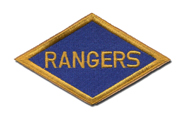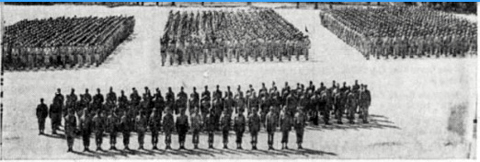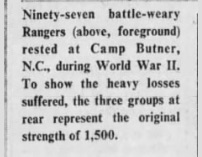By Nick Lamberto But before the end of World War II, these same men – members of the U.S. Army Rangers – had participated in seven invasions, leaving a trail of bravery and blood from the sands of North Africa and the scraggy cliffs of Normandy to the jungle trails of Luzon in the Phillippines. [excerpted] Rugged Training. “Those were the days in 1940 and 1941 when we thought we could serve our year under Selective Service and get out,” said one Ranger. There even was a song, “Goodbye, Dear. I’ll be back in a Year.” But when war came many of us ended up serving four and five years.” For Americans, World War II lasted from Dec. 7, 1941, until Sept. 2, 1945, when Japan surrendered. (Germany surrendered May 7, 1945.) Iowa’s 34th Infantry Division, originally a National Guard unit, and the First Armored Division furnished cadre members for the newly formed Rangers when they started training at Achnicarry, Scotland, in the summer of 1942. At least two men died in training there.
Killed in Italy. Enemy Fire. Koons was credited with being “the first American soldier in the Second World War to kill a German soldier in Europe.” Three Rangers died at Dieppe. Of 5,000 troops sent on the raid, 3000 did not return. At total of 1,131 Allied servicemen were killed. After the baptism at Dieppe, the Rangers kept training new volunteers, Elmer (Dutch) Vermeer took training for the Normandy invasion on the Isle of Wight. He and Max Schneider of Shenandoah were members of the Second and Fifth Ranger Battalions that scaled almost impossible cliffs on D-Day, June 6, 1944, to destroy German gun batteries. Before the D-Day invasion, Rangers had participated in invasions of North Africa, Sicily, Salerno and Anzio (in Italy.) Later they took part in invasions of Leyte and Luzon in the Philippines. They participated in major battles at Arzew, Dernia Pass, El Guettar, Gela, Licata, Porto Empodocile, Butera, Messina, Chiunzi Pass, Venafro, San Pietro, Cisterna, Omaha Beach, Vierville, Grancamp, La Coquet Peninsula, Brest, Huertgen Forest, Point Du Hoc, Hill 400 and 105, Zerf, Oberleuken, the Bulge, Leyte and Manila. Saw Patton. Les Kness and his brother Mike Kness, of Albia, were among the six sets of brothers from Iowa who served with the Rangers. Ranger Dean Hooker, of Des Moines, visited the grave of his brother, John, at Venafro, Italy, after John Hooker was killed Nov. 11, 1943. On that same day, Ranger Wilbur Gallup, of Council Bluffs, was hit by a mortar shell and lost part of his cheekbone. William Proudfit, of Des Moines, was a member of Sixth Ranger Battalion that fought in New Guinea and the Philippines and raided a prison camp at Cabanatuan north of Manila to rescue survivors of the infamous death march. Lt. Gino Mercuriali of Cedar Rapids was featured in a Life magazine story July 31, 1944. In the “before” photo, top, he is described as unlined, boyish. In the “after” picture, below, he is described as wiser and older. In a commemorative book about the Rangers, James J. Altieri, a Ranger himself, said: “What best exemplified the spirit and loyalty of Rangers was the exceedingly large number of hospital AWOLs (absent without leave) whenever the battalions went into battle. These were called ‘AWOLs in reverse’ because instead of going ‘over the hill’ to evade battle, they would leave comparative safety to join buddies on the firing lines.” Source: The DesMoines Register, Sunday, July 27, 1975 p. 21 (Photos of 25 Iowa Rangers were included with this newspaper article -- see left column name links)
~Transcribed & Page format by Linda Ziemann, Aug 2020 |



